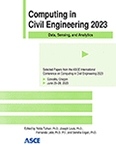Investigating Personal Environmental Conditions for a Wheelchair User to Identify Disability-Related Inequity by Building Design and Maintenance
Publication: Computing in Civil Engineering 2023
ABSTRACT
The disability-related inequity has been identified in the built environment, causing discomfort in their essential routines. Current legislation focuses on building design and construction but not on the actual experiences of those with disabilities, like wheelchair users. These occupants encounter significant issues such as seat discomfort and unhealthy air quality due to their lower breathing zone. Although there are some research efforts on wheelchair user monitoring, there is limited information on the personal environmental conditions of wheelchair users, especially regarding their navigation in buildings. In this paper, we used WheelCom, an open source based toolkit to identify breathing and seat discomfort of a wheelchair user to assess actual perception and experience. We recruited a wheelchair user and installed WheelCom on the participant’s wheelchair to follow the typical trajectory. Our outcomes would motivate architects, engineers, planners, and policymakers to rethink the accessibility and inclusion of buildings from the perspective of wheelchair users.
Get full access to this article
View all available purchase options and get full access to this chapter.
REFERENCES
Adgate, J. L., Weisel, C., Wang, Y., Rhoads, G. G., and Lioy, P. J. (1995). Lead in house dust: relationships between exposure metrics. Environmental research, 70(2), 134–147.
EPA. (2023). National Ambient Air Quality Standards (NAAQS) for PM. Retrieved March 13, 2023, from https://www.epa.gov/pm-pollution/national-ambient-air-quality-standards-naaqs-pm.
Ferro, A. R., Kopperud, R. J., and Hildemann, L. M. (2004). Source strengths for indoor human activities that resuspend particulate matter. Environmental science & technology, 38(6), 1759–1764.
García-Florentino, C., Maguregui, M., Carrero, J. A., Morillas, H., Arana, G., and Madariaga, J. M. (2020). Development of a cost effective passive sampler to quantify the particulate matter depositions on building materials over time. Journal of cleaner production, 268, 122134.
Harms, M. (1990). Effect of wheelchair design on posture and comfort of users. Physiotherapy, 76(5), 266–271.
Kelly, F. J., and Fussell, J. C. (2011). Air pollution and airway disease. Clin. Exp. Allergy 41 (8), 1059–1071.
McClain, L., Medrano, D., Marcum, M., and Schukar, J. (2000). A qualitative assessment of wheelchair users’ experience with ADA compliance, physical barriers, and secondary health conditions. Topics in Spinal Cord Injury Rehabilitation, 6(1), 99–118.
McCullough, S., Eisma, J., Park, J. Y., Salazar, M., and Rose, S. F. (2022, November). Inequity by inequity: community driven investigation of wheelchair user discomfort by infrastructure failures. In Proceedings of the 9th ACM International Conference on Systems for Energy-Efficient Buildings, Cities, and Transportation (pp. 274–277).
Monette, M., Weiss-Lambrou, R., and Dansereau, J. (1999). In search of a better understanding of wheelchair sitting comfort and discomfort. In Proc. of the RESNA An. Conf (pp. 218–220).
Paton, S., Thompson, K. A., Parks, S. R., and Bennett, A. M. (2015). Reaerosolization of spores from flooring surfaces to assess the risk of dissemination and transmission of infections. Applied and Environmental Microbiology, 81(15), 4914–4919.
Postolache, O., Pereira, J. D., Girão, P. S., and Postolache, G. (2012). Systems for remote monitoring of indoor air quality and respiration of wheelchair users. In International Multi-Conference on Systems, Signals & Devices (pp. 1–6). IEEE.
Qian, J., and Ferro, A. R. (2008). Resuspension of dust particles in a chamber and associated environmental factors. Aerosol Science and Technology, 42(7), 566–578.
Qian, J., Peccia, J., and Ferro, A. R. (2014). Walking-induced particle resuspension in indoor environments. Atmospheric Environment, 89, 464–481.
Scherer, M. J. (1996). User desires for wheelchairs. RERC-TET study shows manufacturers would do well to listen to consumers. Rehabilitation Engineering Research Center on Technology Evaluation and Transfer. Rehab Management, 9(4), 121–123.
Shaw, G. (1991). Wheelchair seat comfort for the institutionalized elderly. Assistive Technology, 3(1), 11–23.
Stone, D. J., and Keltz, H. (1963). The effect of respiratory muscle dysfunction on pulmonary function: studies in patients with spinal cord injuries. American Review of Respiratory Disease, 88(5), 621–629.
Tian, Y., Sul, K., Qian, J., Mondal, S., and Ferro, A. R. (2014). A comparative study of walking‐induced dust resuspension using a consistent test mechanism. Indoor air, 24(6), 592–603.
Titchkosky, T. (2007). Reading and writing disability differently: The textured life of embodiment. University of Toronto Press.
Van Loan, M. D., McCluer, S., Loftin, J. M., and Boileau, R. A. (1987). Comparison of physiological responses to maximal arm exercise among able-bodied, paraplegics and quadriplegics. Spinal Cord, 25(5), 397–405.
WHO (World Health Organization). (2016). Ambient Air Pollution: A Global Assessment of Exposure and Burden of Disease. World Health Organization.
Information & Authors
Information
Published In
History
Published online: Jan 25, 2024
ASCE Technical Topics:
- Air pollution
- Air quality
- Architectural engineering
- Building design
- Building management
- Buildings
- Business management
- Construction engineering
- Construction management
- Design (by type)
- Engineering fundamentals
- Environmental engineering
- Geomatics
- Government
- Legislation
- Maintenance and operation
- Navigation (geomatic)
- Organizations
- Pollution
- Practice and Profession
- Structural engineering
- Structures (by type)
Authors
Metrics & Citations
Metrics
Citations
Download citation
If you have the appropriate software installed, you can download article citation data to the citation manager of your choice. Simply select your manager software from the list below and click Download.
